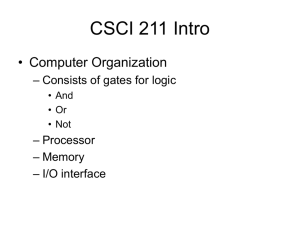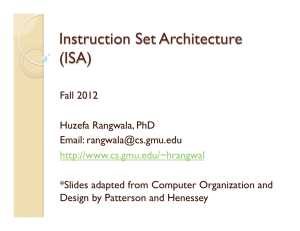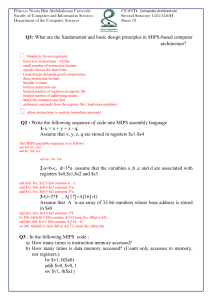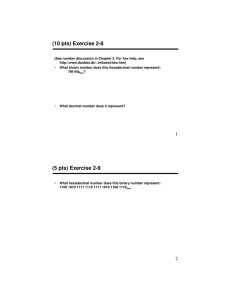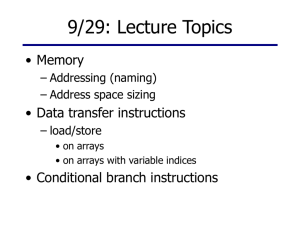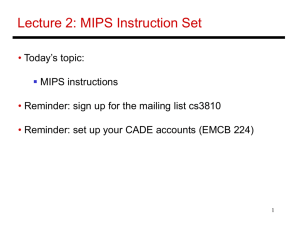Components of a Computer p I t ti
advertisement
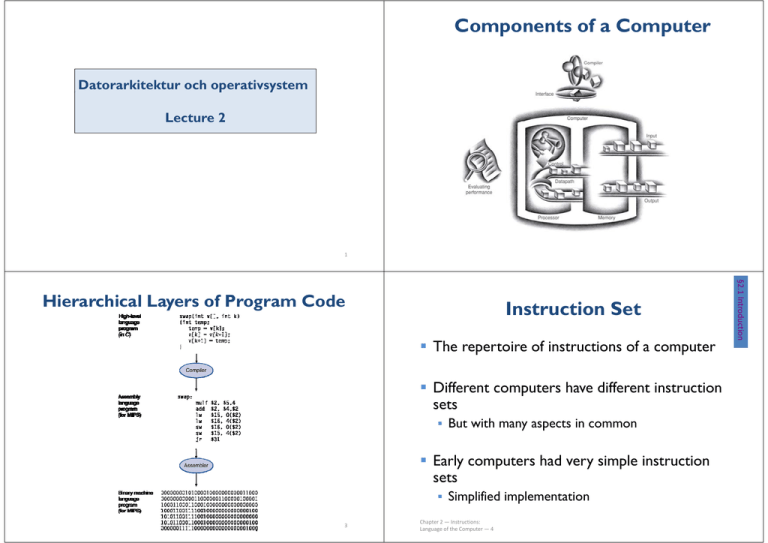
Components p of a Computer p Datorarkitektur och operativsystem p y Lecture 2 1 I t Instruction ti Set S t The repertoire of instructions of a computer Different computers have different instruction sets But B t with ith many aspects t in i common Early computers had very simple instruction sets Simplified implementation 3 Chapter 2 — Instructions: Language of the Computer — 4 §2.1 Inttroductio on Hierarchical Layers of Program Code Th MIPS Instruction The I t ti S Sett I t Instruction ti Set S t Used as the example throughout the book Stanford S f d MIPS commercialized i li d by b MIPS Technologies T h l i (www.mips.com) Stored-program concept The idea that instructions and data of many types can be stored in memoryy as numbers, leadingg to stored-program computer Founded in 1984 by …? Large share of embedded core market Applications in consumer electronics, network/storage Let us look into MIPS instruction set one byy one to understand this equipment cameras, equipment, cameras printers, printers … Typical of many modern ISAs Chapter 2 — Instructions: Language of the Computer — 5 Two sources and one destination add a, b, c # a gets b + c A ith Arithmetic ti Operations O ti Operand is a quantity on which an operation is performed add a, b, c How many operands in this instruction? All arithmetic operations have this form Chapter 2 — Instructions: Language of the Computer — 7 Chapter 2 — Instructions: Language of the Computer — 8 §2.2 Op perationss of the C Computeer Hardw ware Add and subtract, three operands §2.2 Op perationss of the C Computeer Hardw ware A ith Arithmetic ti Operations O ti 6 What if we want to add b,c,d, and e and put the result into a ? All arithmetic operations have this form Design Principle 1: Simplicity favors regularity Regularity makes hardware implementation simpler Chapter 2 — Instructions: Language of the Computer — 10 Chapter 2 — Instructions: Language of the Computer — 9 A ith Arithmetic ti Example E l C code: A ith Arithmetic ti Example E l C code: f = (g + h) - (i + j); Compiled MIPS code: D i Principle Design P i ipl 1 ? f = (g + h) - (i + j); Compiled MIPS code: add dd t0, 0 g, h add t1, i, j sub f, t0, t1 Chapter 2 — Instructions: Language of the Computer — 11 Chapter 2 — Instructions: Language of the Computer — 12 # temp t0 0 = g + h # temp t1 = i + j # f = t0 - t1 §2.2 Op perationss of the C Computeer Hardw ware All arithmetic operations have this form §2.2 Op perationss of the C Computeer Hardw ware A ith Arithmetic ti Operations O ti Registers g are pprimitives of hardware design g and are visible to programmers Chapter 2 — Instructions: Language of the Computer — 13 R i t O Register Operand d Example E l Compiler’s job to associate variables of a highlevel program with registers C code: f = (g + h) - (i + j); f, …, j in $s0, …, $s4 R i t Operands Register O d Assembler names $t0, $t1, …, $t9 for temporary values $s0, $s0 $s1, $s1 …, $s7 for saved variables Chapter 2 — Instructions: Language of the Computer — 14 R i t O Register Operand d Example E l Compiled MIPS code: add $t0 $t0, $s1, $s1 $s2 add $t1, $s3, $s4 sub $s0, $s0 $t0, $t0 $t1 Compiled MIPS code ? Chapter 2 — Instructions: Language of the Computer — 15 Chapter 2 — Instructions: Language of the Computer — 16 §2.3 Op perands o of the Co omputer Hardware The operands of arithmetic instructions must be from special location in hardware called registers §2.3 Op perands o of the Co omputer Hardware R i t Operands Register O d Numbered 0 to 31 32-bit data called a “word” Word is the natural unit of access, typically yp y 32 bits, corresponds to the size of a register in MIPS D i Principle Design P i ipl 2 Smaller is faster Larger registers will increase clock cycle time --- electronic signals takes longer when they travel farther Design principles are not hard truths but general guidelines 31 registers instead of 32 need not make MIPS faster There may be only 3 operands and they must be chosen from one of the 32 registers registers. Why only 32 ? Chapter 2 — Instructions: Language of the Computer — 17 Chapter 2 — Instructions: Language of the Computer — 18 M Memory Operands O d Programming languages, C, Java, … Allow complex data structures like arrays and structures They Th often f contain many more data d elements l than h the h number b of registers in a computer Where are they y stored ? • Memory But, arithmetic operations are applied on register operands Hence, data transfer instructions are required to transfer data from memory to registers Load values from memory into registers Store result from register to memory Chapter 2 — Instructions: Language of the Computer — 19 Memory is like an array Data D t transfer t f iinstructions t ti mustt supply l the th address dd (index/offset) of the memory (array) 20 §2.3 Op perands o of the Co omputer Hardware MIPS has a 32 × 32-bit register file §2.3 Op perands o of the Co omputer Hardware R i t Operands Register O d M Memory Operands O d Memory is byte addressed Each address identifies an 8-bit byte y Words are aligned in memory Each word is 32 bits or 4 bytes y To locate words, addresses are in multiples of 4 A is an array of words What is the offset to locate A[8] ? A[0] – 0 A[1] – 4 A[2]– 8 … Chapter 2 — Instructions: Language of the Computer — 21 M Memory Operands O d Why is memory not word-addressable? A[8] – 32 M Memory Operands O d Why is memory not word-addressable? Bytes are useful in many programs. In a word addressable system, it is necessary first to compute the address of the word containing the byte, fetch that word word, and then extract the byte from the two two-byte byte word. word Although the processes for byte extraction are well understood, they are less efficient than directly accessing the byte. For this reason, many modern machines are byte addressable. addressable Chapter 2 — Instructions: Language of the Computer — 23 Chapter 2 — Instructions: Language of the Computer — 24 22 M Memory Operands O d M Memory Operand O d Example E l 1 C code: Load instruction lw refers to load word lw registerName, offset (registerWithBaseAddress) g = h + A[8]; g in $s1 h in $s2 base address of A in $s3 A is an array of 100 words lw $t0 , 8 ($s3) Compiled MIPS code ? offset base register 25 M Memory Operand O d Example E l 1 C code: Compiled MIPS code: lw $t0 $t0, 32($s3) add $s1, $s2, $t0 Chapter 2 — Instructions: Language of the Computer — 27 M Memory Operand O d Example E l 2 C code: g = h + A[8]; [ ] g in $s1, h in $s2, base address of A in $s3 offset Chapter 2 — Instructions: Language of the Computer — 26 A[12] [ ] = h + A[8]; [ ] h in $s2, base address of A in $s3 Compiled MIPS code: # load word base register Chapter 2 — Instructions: Language of the Computer — 28 M Memory Operand O d Example E l 2 C code: A[12] [ ] = h + A[8]; [ ] h in $s2, base address of A in $s3 Compiled MIPS code: Index 8 requires offset of 32 lw $t0 $t0, 32($s3) add $t0, $s2, $t0 sw $t0, $t0 48($s3) 48($ 3) # load word # store t word d Chapter 2 — Instructions: Language of the Computer — 29 R i t Registers vs. Memory M Registers are faster to access than memory Operating O i on memory d data requires i loads l d and d stores More instructions to be executed Compiler must use registers for variables as much as possible Only spill to memory for less frequently used variables Register optimization is important! Chapter 2 — Instructions: Language of the Computer — 30 I Immediate di t Operands O d Constant data specified in an instruction addi ddi $s3, $ $s3, $ 4 No subtract immediate instruction D i Principle3 Design P i ipl 3 Make the common case fast Small constants are common Immediate operand avoids a load instruction Just use a negative constant addi $s2, $s1, -1 Chapter 2 — Instructions: Language of the Computer — 31 Chapter 2 — Instructions: Language of the Computer — 32 Th Constant The C t tZ Zero MIPS register 0 ($zero) is the constant 0 Stored-program concept Cannot be overwritten The idea that instructions and data of many types can be stored in memoryy as numbers, leadingg to stored-program computer Useful for common operations E.g., move between registers add $t2, $s1, $zero Chapter 2 — Instructions: Language of the Computer — 33 Instructions are encoded in binary Called machine code MIPS instructions Encoded E d d as 32-bit 32 bi iinstruction i words d Small number of formats encoding operation code ((opcode), d ) register i t numbers, b … Regularity! Register numbers $t0 – $t7 are reg’s 8 – 15 $s0 – $s7 are reg’s 16 – 23 Chapter 2 — Instructions: Language of the Computer — 35 §2.5 Reepresentiing Instru uctions in n the Computer R Representing ti Instructions I t ti 34 E Example l add $t0, $s1, $s2 special $s1 $s2 $t0 0 add 0 17 18 8 0 32 000000 10001 10010 01000 00000 100000 000000100011001001000000001000002 op rs rt rd shamt funct 6 bits 5 bits 5 bits 5 bits 5 bits 6 bits Chapter 2 — Instructions: Language of the Computer — 36 R Representing ti Instructions I t ti I t Instruction ti types t The layout or the form of representation of instruction is composed of fields of binary numbers R format (for register) Add, sub The numeric version of instructions is called machine language and a sequence of such instructions is called machine h code d I-format (for immediate) Immediate Data transfer 37 MIPS R-format Rf t Instructions I t ti 38 MIPS I-format If t Instructions I t ti op rs rt rd shamt funct op rs rt constant or address 6 bits 5 bits 5 bits 5 bits 5 bits 6 bits 6 bits 5 bits 5 bits 16 bits Instruction fields op: operation ti code d (opcode) ( d ) rs: first source register g number rt: second source register number Immediate arithmetic and load/store instructions rt: destination or source register number Constant: –215 to +215 – 1 Address: offset added to base address in rs rd: d destination d i i register i number b shamt: shift amount ((00000 for now)) funct: function code (extends opcode) Chapter 2 — Instructions: Language of the Computer — 39 Chapter 2 — Instructions: Language of the Computer — 40 D i Principle Design P i i l 4 H Hexadecimal d i l Keep all instructions of the same format and length But it makes difficult to address large memories Compromise and allow different formats Reading binary numbers are tedious So, hexadecimal representation is popular Base 16 is power of two and hence it is easy to replace each group of 4 binary digits Good design demands good compromises Different formats complicate decoding, decoding but allow 32-bit 32 bit instructions uniformly Keep formats as similar as possible See example in page 98 41 Base 16 H Hexadecimal d i l 42 St Stored dP Program Computers C t Instructions represented p in binary, just like data Instructions and data stored in memory Programs can operate on programs Compact representation of bit strings 4 bits bit per hex h di digit it 0 1 2 0000 0001 0010 4 5 6 0100 0101 0110 8 9 a 1000 1001 1010 c d e 1100 1101 1110 3 0011 00 7 0111 0 b 1011 0 f 1111 Example: eca8 6420 ? p Example: 0001 0011 0101 0111 1001 1011 1101 1111 e.g., compilers, il lilinkers, k … Binary compatibility allows compiled programs to work on different computers Standardized ISAs Chapter 2 — Instructions: Language of the Computer — 44 CISC A Approach h CISC vs RISC Complex Instruction Set Computer C code: d C code: g = h + A[8]; [ ] g = h + A[8]; [ ]; CISC CISC add a,<b> add dd a,32<b> 32<b> Compiled MIPS code: Achieved byy buildingg complex p hardware that loads value from memory into a register and then adds it to register a and stores the results in register a lw $t0 $t0, 32($s3) add $s1, $s2, $t0 45 CISC vs RISC # load word Chapter 2 — Instructions: Language of the Computer — 46 CISC Advantages Ad t Compiler has to do little CPU Time Instruction Count CPI Clock Cycle Time Programming P i was done d in i assembly bl language l To make it easy, more and more complex instructions were added Length of the code is short and hence, little memory is required to store the code Memory M was a very costly l real-estate l E.g., g , Intel x86 machines ppoweringg several million desktops 47 48 RISC Advantages Ad t RISC Roadblocks R dbl k Each instruction needs only one clock cycle Hardware is less complex RISC processors, despite their advantages, tookk severall years to gain i market k Intel had a head start of 2 years before its RISC competitors Customers C t were unwilling illi tto ttake k risk i k with ith new technology and change software products They have a large market and hence, they can afford resources to overcome complexity 49 Powerful instruction higher performance Fewer F iinstructions t ti required i d But complex instructions are hard to implement • May slow down all instructions, including simple ones §2.18 Fallacies aand Pitfaalls F ll i Fallacies 50 F ll i Fallacies Backward compatibility instruction set doesn’t change But they do accrete more instructions Compilers are good at making fast code from simple instructions Use assemblyy code for high g performance p x86 instruction set But modern compilers are better at dealing with modern processors More lines of code more errors and less productivity Chapter 2 — Instructions: Language of the Computer — 51 Chapter 2 — Instructions: Language of the Computer — 52 Pitf ll Pitfalls CISC vs RISC Sequential words are not at sequential addresses dd Very good slides on the topic https://www.cs.drexel.edu/~wmm24/cs281/lecture s/pdf/RISCvsCISC.pdf p p Increment by 4, not by 1! Chapter 2 — Instructions: Language of the Computer — 53 54 Ad i i t ti Details Administrative D t il Patterson’s blog: 1.1, 1.2, 1.3, and 1.4 http://blogs.arm.com/software-enablement/375- Note the correction – 1.4 was not listed in risc-versus-cisc-wars-in-the-prepc-and-pc-erasp p p part-1/ part of covered material lecture 1 but it is p Interview with Hennessy 2.1, 2 1 2.2, 2 2 2.3 2 3 , 2.5, 2 5 2.18, 2 18 2.19 2 19 http://www-csp aculty.stanford.edu/~eroberts/courses/soco/projec ts/risc/about/interview.html An experiment p with – Twitter! unmesh_bordoloi 55 56 56 Design principles 1.Simplicity 1 Si li it ffavors regularity l it 2.Smaller is faster 3.Make the common case fast 4 Good design demands good compromises 4.Good Layers of software/hardware Compiler, assembler, hardware MIPS: typical of RISC ISAs c.f. x86 Chapter 2 — Instructions: Language of the Computer — 57 §2.19 C Concludin ng Remarks C Concluding l di Remarks R k
